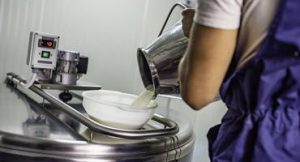
According to Juan Piñeiro, Assistant Professor and Extension Dairy Specialist with Texas A&M, Texas’s milk production has increased an impressive 190%, going from 5.1 billion lb. to 14.8 billion lb. from 2001 to 2020.
The expansion of milk processing capacity and new plant construction in the Panhandle has spurred the increase in both cow numbers and production that Texas has seen.
A privately-owned maker of Mexican-style cheese, Cacique LLC, is scheduled to begin operation of a processing facility in Amarillo this fall. Just 50 miles north, in Dumas, another plant is also under construction. A new Leprino mozzarella cheese and dairy ingredients plant is scheduled to break ground in Lubbock this summer, with anticipated completion in two phases by early 2026.
Additionally, northeast of the Panhandle, Hilmar Cheese Company is building a cheese and whey protein processing plant that is expected to be fully operational in 2024 in Dodge City, Kan.
“Some of the milk from the Texas panhandle will be diverted towards that plant,” Piñeiro says.
While the USDA March production report illustrates a 0.5% decline compared to last month, the rate of decline is slowing due to an increase in cow numbers. Both January and February documented a 1.7% and 0.9% decline, respectively.
Following suite, cow numbers show 87,000 fewer cows year-over-year. Meanwhile, March’s cow numbers were 15,000 more than February and 28,000 more than January.
The following six states account for 62% of national milk production. In addition to Texas, two other states trending are South Dakota, up 20%, which results from 33,000 additional cows and 57 million additional lb. of milk. However, New Mexico is down 9.3%, with 37,000 fewer cows and minus 67 million lb. of milk.
————–State Production % Change Cow Numbers
California 3.743 billion 0.5 +1,000
Wisconsin 2.724 billion 0.2 +3,000
Texas 1.437 billion 6.7 +22,000
Idaho 1.392 billion 0.0 no change
New York 1.327 billion – 1.0 -6,000
Michigan 1.006 billion -2.9 -15,000
Will Texas Inch Higher?
With No. 2 Wisconsin producing nearly double of Texas, Piñeiro thinks it’s unlikely that Texas will ever produce more milk than California or Wisconsin.
With water scarcity a main challenge for the Texas Panhandle, dairy farmers are maximizing water efficiency and adding more economic value to water use compared to cash crops.
“The Panhandle is a semi-desert, with roughly 12 to 18 inches of precipitation a year,” Piñeiro says. “We are in a severe drought right now. Further improving water efficiency with the use of new irrigation technologies, drought-tolerant crops, hydroponic systems and management practices considering soil health, among other strategies, will be key in the future.”























